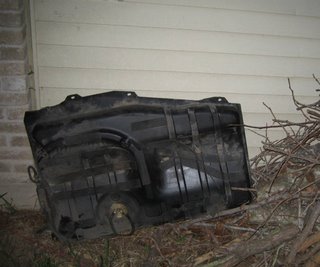The clutch and pressure plate are off the engine!
It's been a while since an update. I've been spending the time cleaning the rust off of the battery boxes. An angle grinder with a wire wheel took care of the big chunks and a $13 Home Despot sand blaster took care of the nooks and crannies. (Thanks for the REAL compressor Jeremy)A little more cleanup and it'll be time to repaint. I just received a can of acid resistant battery box paint which will hopefully keep the rust from starting again.
Now with the clutch off, the EV officially starts to go back together. Woohoo! I started reassmbling the pressure plate assembly to ElectroAuto's nifty taperlock hub, but need to make a run for the right size bolt tommorow. The tear down was fun, but putting the Cabriolet back together is even better. Speaking of which, we've been having such great weather recently, barring the hail storms, that I've really been missing the convertible. Hopefully it'll be back on the road soon. Sorry about the lack of pictures, my camera's hiding from me.
As an aside I came across Terrapass today. They are a company which buys carbon credits with the buying power of a large company, and resells them to anyone interested. This lets anyone buy carbon credits at a reasonable rate, pretty cool.
Erik



